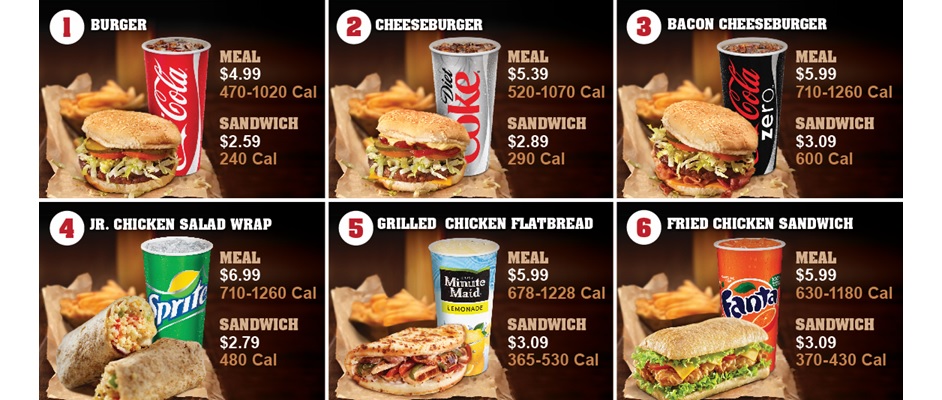Are you preparing for menu labeling?
By: Guest columnist Judy Barbe, registered dietitian
As the menu labeling becomes reality, expect to see some reality TV. The media, activist groups, and others are likely to play “Gotcha!” Be it a blog, tweet, secret shopper, or television expose, the inquisitive will be looking for a story.
Because the point of menu labeling is to help Americans be healthier, an expected report is the discrepancy between the calorie count posted and the calorie count found by the investigator. The likely culprits that will draw interest will be the highest and lowest calorie items on your menu. Many will be looking for calorie counts, so you want to make sure these are accurate.
Another anticipated story is whether you are part of the obesity problem or part of the solution. To demonstrate you are part of the solution, a resized menu item or reduced size container, offering baked chips rather than fried, using lower fat cheese, sour cream or Greek yogurt will lower calorie counts. Even a few examples on your menu points to being part of the solution.
The best “gotcha” defense is a better offense. Here are 3 ways to gear up for 2016.
1. Be prepared.
The ideal scenario is that you never need to defend your menu, but the reality is that you will, so better to be prepared than caught off guard.
Work with your suppliers to create a body of data that support your menu. In case items are called into question, you’ll have a stronger platform to stand on when you can back up your claim. Establish validation programs and sampling plans with monitoring procedures for suppliers. Set up a system for communicating formula changes including nutrition and allergen changes. Is there a system in place to monitor these? Perhaps you want to ”secret shop” your operation to test the products and portions. Where there is subjectivity to the portion/serving, there is room for error. The difference between your drizzle and my drizzle can change calories. Use this as a learning tool to retrain on preparation and portion control. With these strategies you insure information is accurate plus you are defending your brand and image.
2. Choose a company spokesperson.
The communications are strongest when an organization speaks with one voice. Who will speak on the company’s behalf? Are your statements ready? What is the chain of command in your operation? Do employees know this?
Determine in advance who will speak to the news media and prepare that spokesperson with talking points, so they can speak clearly and effectively in terms that can be easily understood. If you’re the spokesperson, what will happen if you’re out of the office?
A strong communications plan means that only authorized spokespersons are permitted to speak to the news media. But if your employees don’t know that or don’t follow it, there will likely be a “clean up on aisle 2” and you’ll undoubtedly be doing damage control. Communicate the policy to all employees explaining that it is best to speak with one informed voice. Then remind them. Again.
3. Train employees on how to handle guest questions and media inquiries.
Since your customers are the life of your business, the better skilled employees are in assisting guests, the better you look.
Identifying “lighter” menu options for guests watching their calories, steering those with food allergies or intolerances to safer options, and knowing which menu items are suitable for vegetarians can increase sales because they fill the need of the customer.
With the new menu labeling, businesses must provide nutrition information, upon request, in a written form, such as a pamphlet, IPAD, 3-ring notebook or a kiosk that links to your website. Employees should know where that information can be found and how to direct guests to find it.
We all know this is coming. With some preparation on the front end, you will set yourself up for success and minimize damages should someone stick a microphone in front of you.
The clock is ticking.
By: Guest columnist Judy Barbe, registered dietitian
We often hear the journey is part of the destination.
Speed bump!
Because of Section 4205 of the Patient Protection and Affordable Care Act, the journey is about menu labeling in food service operations. The destination is to have a healthier population.

The clock is ticking to reprint menus, rebuild menu boards, update websites, and develop onsite information delivery points. December 1, 2015 is the effective date for implementation. The seemingly short deadline balances the industry’s need to make it happen with the public health need for the information. As Americans eat more food away from home, this is part of the global effort to help consumers identify the calorie-rich culprits.
At the recent CinemaCon 2015 conference in Las Vegas, slot machines weren’t the only bells ringing. Food service operators, concessionaires, and theatre owners, who attended the National Association of Concessionaires (NAC) and National Association of Theatre Owners (NATO) sponsored session The How-to Guide for Compliance with the FDA Menu Labeling Regulations, heard the alarm.
Along with other panelists, Food and Drug Administration’s (FDA) General Health Scientist, Claudine Kavanaugh, PhD, reviewed the FDA food service menu labeling requirements that are to be implemented by the end of the year.
WHO
The menu labeling law applies to restaurants and similar retail food establishments that are:
1. part of a chain with 20 or more locations,
2. doing business under the same name,
3. offering substantially the same menu items, and
4. selling “restaurant type food,” which means food that is usually eaten on the premises, foods that are self-serve and intended for immediate consumption.
WHAT
Those businesses that meet the criteria above must:
1. disclose calorie information on menus and menu boards for standard menu items (including combo meals),
2. disclose calorie information on signs adjacent to foods on display and self-service foods that are standard menu items,
3. post a succinct statement concerning suggested daily caloric intake on menus and menu boards to help consumers put the information in the context of their daily diet on menus and menu boards such as “2,000 calories a day is used for general nutrition advice, but calorie needs vary,”
4. provide nutrition information, upon request, in a written form, such as a pamphlet, IPAD, 3-ring notebook or a kiosk that links to your website, and
5. post on menus and menu boards a statement that written nutrition information is available upon request. Employees should know where to direct guests in order to access it.
Operators can determine calorie and nutrient values from a variety of sources including nutrient databases, laboratory analysis, nutrition facts labels on packaged goods, cookbooks, and other reasonable means. Upon request from the FDA, establishments must provide information substantiating the menu and calorie claims.
The FDA advises owners and operators of restaurants, similar retail food establishments and vending machines to review the final rule on “Food Labeling: Nutrition Labeling of Standard Menu Items in Restaurants and Similar Retail Food Establishments” to ensure that they are familiar with its specific requirements. The agency also has prepared an overview and related resources. If you have specific questions regarding menu labeling and vending machine labeling, submit your questions to FDA with these email addresses:
Menu Labeling: CalorieLabeling@fda.hhs.gov
Vending Machine labeling: CalorieLabelingVend@fda.hhs.gov
WHEN
While there have been requests for an implementation extension, the December 1, 2015 deadline is set. As the date draws closer, Kavanaugh said the FDA is looking for a “good faith effort” in menu labeling. According to Kavanaugh, this year has been focused on education about the rule to help operators understand the changes and become compliant. NAC, its members and affiliated trade groups are also working toward industry solutions. NATO conducted venue tours to educate FDA on how the law impacts theatre owners. Coca-Cola’s Joel Neuman highlighted new menu boards during the session and in real time at the CinemaCon 2015 Trade Show. Brad Derusseau, CinemaScene and Rodrick Glass, Allure Global Solutions shared digital menu board concepts to help bring the information to life. If they haven’t yet shared innovations with you, check with your vendors to see how they are preparing for menu labeling.
WEBINAR
Of course, a Public Law has more rules and regulations than we can fit in a single article. You can find details on the www.naconline.org. NAC is also hosting a menu labeling webinar with Dr. Kavanaugh, Thursday, May 28 from 1:30 – 2:30 PM EST. You can join this meeting from your computer, tablet or smartphone.
https://gotomeet.me/MLAI
You can also dial in using your phone.
United States : +1 (872) 240-3412
Access Code: 499-102-253
Category: Feature






